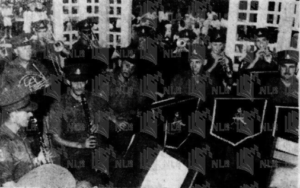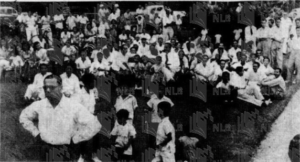In 1949, Sir John Forsdyke, Director of the British Museum, lectured to the Royal Society of Arts on how ‘the most important educational service, common to all museums is the entertainment and instruction of children’’.1 He explained how museums could feature two forms of popular entertainment; ‘music and the cinema’.2 Forsdyke’s lecture reflected Gareth Knapman’s observation that during the 19th century, museums were ‘as much about entertainment as research’3 , and the audience that museums attracted ‘was looking for entertainment’.4 I found this shift towards museums becoming spaces for popular entertainment instead of practices for solely academically important topics interesting, as this shift also occurs within Singapore’s Botanic Garden. This blog post focuses on how the development of the museum into a space of entertainment also occurs in Singapore’s Botanic Gardens. This is an important focus as it is a useful contribution towards my broader long essay idea that the Singapore Botanic Gardens was Singapore’s first museum. The Singapore Botanic Gardens strayed from its defined purpose of a space for ‘the scientific study of plants’ as it increasingly accommodated entertainment practices.5 The specific entertainment practices in the Singapore Botanic Garden that this blog post will examine are the Gardens’ weekly band performances.
The significance of band performances within the Singapore Botanic Gardens is immediately apparent through their mention in the first by-law published in the Official Guide to the Gardens, printed by the Singapore government in 1889.6
‘The Botanical Gardens shall be open to the public daily from sunrise to sunset, and, on nights when the Band plays, to 11 p.m.’7
This specific mention highlights the importance of entertainment to the Gardens because the by-laws represented the official rules of governance and conduct indicating that entertainment was a formally approved function of the Gardens. Furthermore, extending the opening hours from their regular timings illustrates the Garden purposely catering to the performances and their audiences, suggesting entertainment practices were not only approved but encouraged. The official guide served as the principal medium by which the government communicated to visitors how they wanted the gardens to be viewed and used. Thus, this reference to band performances within the first page publicised not only to officials but also to ordinary visitors that the bands, and other entertainment events, were an integral, standard, and unquestioned service of the Gardens despite their lack of relation to the Gardens’ traditional focus on scientific research. The performances were also a focus of the Garden’s Annual Reports, which featured a section for ‘concerts’.8 This section recorded the number of performances that year and other shows, such as ‘variety shows’ staged in the Gardens.9 This official practice of recording the entertainment practices further emphasises how the entertainment function of the Gardens was considered important because it was monitored in the same way and within the same medium as the Gardens’ scientific practices. This illustrates how similar to museums, the Singapore Botanic Gardens developed into a space that was ‘as much about entertainment as research’.
Alongside the band performances featuring in the Gardens’ official publications, multiple Singapore newspapers published articles on the performances and advertised when they would occur. For example, the Singapore Monitor included a column covering the time and specific band that would be performing that week in the Gardens.10The bands performed ‘every Sunday’, and the types of bands ranged from school bands, such as the ‘Bartley Secondary School Band’, to official police bands, such as the ‘National Police Cadet Corps Combo’.9 This inclusion of school bands demonstrates the Garden’s spatial practices again aligning with Forsdyke’s focus on museums entertaining children indicating how the themes within the development of museums’ spatial practices are also applicable to Singapore’s Botanic Gardens. Moreover, newspapers detailing the time and type of bands reveals how the public were interested in attending the Botanic Gardens for these events. This again suggests how not only in official discourses such as the by-laws and annual reports was the Garden considered a space for entertainment purposes, but within general society, the Garden was consistently advertised and considered as a space of entertainment.

Part of the RA band that gave a concert at the Botanic Gardens11

Crowds of people at the Singapore Botanic Gardens listen to the concert by the RA Band.12
Overall, the process of entertainment activities becoming an increasingly central spatial practice within museums also occurs in Singapore’s Botanic Garden. The Gardens hosted weekly music performances that it would stay open longer than usual for, and ‘concerts’ were tracked and monitored in official government reports on the Gardens. These characteristics reveal how, within official discourses, entertainment was considered a dominant spatial practice within the Gardens. Furthermore, national newspapers continuously informed the public of these performances highlighting how the Gardens were also becoming known in popular society through these entertainment practices signalling how entertainment became a critical service within a space, that similar to the museum, was traditionally confined to non-entertainment services. This similarity between the two spaces demonstrates a characteristic that indicates the Singapore Botanic Gardens should be considered Singapore’s first museum.
- John Forsdyke, “The Functions of a National Museum,” Journal of the Royal Society of Arts 97 (1949): pp. 506-517, https://doi.org/https://www.jstor.org/stable/41363863, 513. [↩]
- Ibid., 514. [↩]
- Sarah Longair and John McAleer, Curating Empire (Manchester University Press, 2012), 91. [↩]
- Ibid., 82. [↩]
- John William Purseglove, “History and Functions of Botanic Gardens with Special Reference to Singapore,” Gardens’ Bulletin Singapore, 1959, pp. 125-154, 125. [↩]
- Guide to the Botanical Gardens (Singapore: Government Printing Office, 1889). [↩]
- Ibid., 1 [↩]
- Annual Report of the Botanic Gardens Department (Singapore: Government Printer, 1950), 4. [↩]
- Ibid. [↩] [↩]
- “Miscellaneous Column,” Singapore Monitor, March 9, 1985, 18. [↩]
- Singapore Listens, Malaya Tribune, November 29, 1948, 8. [↩]
- Ibid [↩]